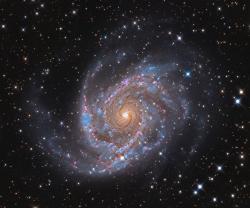
Howdy, Stranger!
It looks like you're new here. If you want to get involved, click one of these buttons!
BlockHead
About
- Username
- BlockHead
- Joined
- Visits
- 257
- Last Active
- Roles
- Member, Administrator
Comments
-
I can see why they chose this image... excellent work!Congrats and enjoy the APOD G L O W... :)-the Blockhead
-
Typically if the normalization of the data is good and there is good overlap in these regions- you shouldn't see black areas. Can you make the calibrated B subs available? When you align to a reference frame- you should pick (or force) a reference i…
-
Hi Ed, Yeah..I agree... towards the end makes sense. However, this is a new method for me also...so I do not know all of the aspects of it yet. -the Blockhead
-
Hi Zak, This is the right place for your question. Thanks.There are a couple of reasons to create a synthetic luminance: 1. There may be artifacts in some of the data- or some other reason that you might combine all of the RGB together in order to g…
-
My guess, without any further knowledge is the Normalization of the data. This is a change. You might try running *without* local normalization. You might also try the experiment of going through registration- and running NSG for the normalization …
-
Hi John, Hmmm... This is a complicated question- and it looks like you have a big project here. I think you need to simplify and just solve the mottling problem... You mention that you think it could be the scaling Factor parameter. I doubt it. None…
-
Hi Mike, I think the general idea of masked stretch is that it is applied to get a linear image- into a non-linear state and take advantage of the masking effect it employs on the brightest elements of the image. So it is likely (but not necessarily…
-
Screenshots of the effect are probably necessary- but when you are zoomed out ,the STF of images is not perfect and can have different kinds of patterns. Remember the *SCREEN* transfer function is a rendering for your screen... but when you permanen…
-
No. ESD is a more "efficient" rejection method. You will not get the same number of values rejected- but of the things it does reject- it does a fantastic job. This means that a sigma threshold method is easier to manipulate (as I demonstrated)- but…
-
Hi Kevin, I cover this in the WBPP series of videos.In your case you will want to integrate all of he exposures together. There is a post-processing exposure tolerance in WBPP that tells WBPP to do this for you. It will result in giving you a single…
-
Hi Mike, Can you please explain you "get no screenshots"?Also, the latest version of WBPP comes with the latest version of PI. What version of PI are you using? You might want to bring it up to date. -the BLockhead
-
Hi Paul, To upload data to share you need to use a cloud drive such as Google Drive, OneDrive, DropBox,...etc etc. You would shared a link to the files or folder and specify that link to be public (available to anyone that has the link). -the Blockh…
-
Paul, Go ahead and provide the calibrated data. This artifact is clearly explained in that thread and you should not get the result you are indicating. A set of 15 files should be more than enough. -the Blockhead
-
Yes, links on my site are orange in color. For FastTrack- you dot he "Training" section first following by the Discussion/Homework section to the right second.-the Blockhead
-
That is great news. I am glad the information was helpful.-the Blockhead
-
Yes- his occurs when you have enabled "High Range Rejection"... to my knowledge, this was disabled by default because of this very issue. You should uncheck this in the ImageIntegration controls if it is enabled. The full answer is here: https://pix…
-
Hi Bruno, Did it work? Did adding the pedestal fix the issue? If the answer is yes, then 500 is a perfectly fine value- this will not eat into your dynamic range in a significant way. I do not know what sensor you have... if you have a 16-bit sensor…
-
P.S. "The Funs" is a great name for the course. LOL
-
(answered in private message)-the Blockhead
-
Hi Jeff, Indeed, I was thinking about it!!I am also trying to get my courage up to do a video on Photometric Mosaic... Let me work on this...-the Blockhead
